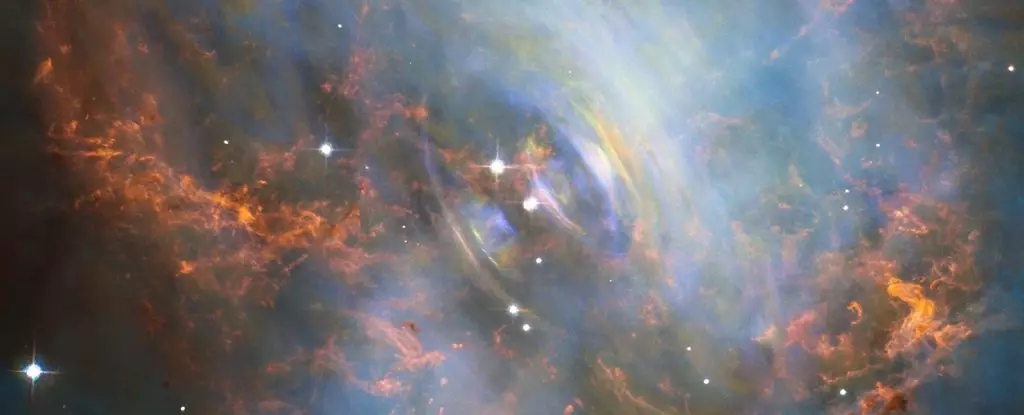In the realm of astrophysics, pulsars represent one of the most captivating phenomena, showcasing nature’s intricate complexities. Among them, the Crab Pulsar stands out not just for its rapid heartbeat but also for the bizarre zebra pattern observed in its emissions. This pulsar, a remnant of a supernova explosion that occurred around 6,200 light-years away, offers deep insights into the universe’s behavior and the forces at play in extreme environments. Since its discovery in the 1960s, scientists have tirelessly sought to unravel the mysteries that surround it, particularly the unusual signals that resemble zebra stripes.
The zebra pattern first came to light in 2007, captivating astronomers with its peculiar appearance. Graphing these emissions reveals a series of spaced wavelength bands that evoke imagery of the stripes on a zebra. This unique characteristic has baffled scientists because no other celestial body exhibits a similar emission profile. The revelation of this pattern added a new layer to the pulsar’s already rich tapestry, making it an even more crucial object of study in modern astrophysics.
Mikhail Medvedev, a theoretical astrophysicist at the University of Kansas, has proposed an intriguing explanation for this phenomenon. He theorizes that the zebra pattern is a result of interference created by the diffraction of light passing through varying plasma densities within the pulsar’s magnetosphere. His approach connects wave optics to the behavior of electromagnetic waves, presenting a sophisticated framework for understanding one of the universe’s peculiar displays.
At the heart of the Crab Pulsar lies a neutron star, which is a core remnant left over after a massive star undergoes gravitational collapse following supernova, a violent cosmic event. Neutron stars are uniquely dense, capable of packing up to 2.3 times the mass of the Sun into a sphere only about 20 kilometers in diameter. The mechanisms driving pulsars involve immense rotational speeds; the Crab Pulsar spins at an astonishing rate of roughly 30 times per second, emitting beams of radio waves that sweep across the cosmos like the beams from a rotating lighthouse.
This pulsating behavior stems from the electromagnetic jets of plasma that surge from its poles. As the neutron star rotates, these jets provide a consistent signal detectable from Earth, culminating in the rhythmic pulsing that characterizes pulsars, and in this case, the Crab Pulsar in particular.
Medvedev’s investigation started with an extensive dataset accumulated from years of observation of the Crab Pulsar. By hypothesizing that the zebra pattern is the result of diffraction, he constructed a model grounded in wave optics, providing a framework for assessing plasma density surrounding the pulsar. His findings suggest that when radio waves emerge from the pulsar, they interact with the magnetic fields and varying plasma densities to create intricate interference patterns.
This revelation is significant; it distinguishes the Crab Pulsar from typical neutron stars, as the magnetic field generates a diverse plasma environment that varies at different distances from the pulsar. The resultant diffraction patterns have distinct spacings that correlate inversely with the frequencies of the radio waves, offering a complex yet comprehensible model that accurately mirrors the observable data.
Implications and Future Research
The implications of Medvedev’s model extend far beyond the Crab Pulsar itself. As it stands, understanding the zebra pattern may pave the way for more profound inquiries into the nature of pulsars and other celestial phenomena where light diffraction plays a role. The knowledge gained could translate into tools for measuring plasma densities in various cosmic settings, enhancing our understanding of the fundamental processes operating in extreme astrophysical conditions.
While the Crab Pulsar is fairly unique—being relatively young and energetically vibrant—it is part of a much broader category of hundreds of known pulsars. Moreover, binary pulsars, which have previously been used to test fundamental theories in physics such as Einstein’s general relativity, may also benefit from the innovative approaches inspired by Medvedev’s findings.
The Crab Pulsar, with its mesmerizing zebra pattern and the insights emerging from its study, emphasizes the dynamic relationship between astrophysical objects and the complex behaviors they exhibit. As scientists like Medvedev push the boundaries of our understanding, the Crab Pulsar continues to serve as a beacon of inquiry, guiding researchers toward new frontiers while unraveling the mysteries of our universe. Through meticulous observation and theoretical exploration, we edge closer to comprehending these celestial enigmas that have long captivated human imagination.


Leave a Reply